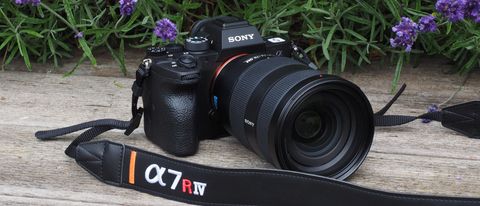The Sony A7R IV should not be thought of solely in terms of resolution, but that 61MP sensor is bound to be what grabs all the headlines. It beats its full frame rivals by some margin and re-establishes Sony as a front-runner in a full-frame mirrorless camera market that’s suddenly become very busy.
The fact is, even though the Mark IV not without its foibles, the Sony A7R IV easily does enough to make it on to our list of the best full frame mirrorless cameras you can buy. It is also only beaten by medium format cameras in our chart of the highest resolution cameras you can buy.
• Read more: Sony A7R IV vs A7R III vs A7R II
But the Sony A7R IV is not just about resolution. It has a very rounded balance of overall image quality and versatility, combining its ultra-high-resolution with 10fps continuous shooting capability and a buffer that can sustain this speed for up to 7 seconds.
Sony’s epic hybrid AF technology takes another step forward too, with 567 phase detection AF points spread across 74% of the image area and 325 contrast AF points. It now offers Real-Time AF tracking in its movie mode too.
And just to drive home the resolution point once more, the Alpha A7R IV has a Pixel Shift Multi Shooting mode than can combine 4 images for full-color data for each pixel (avoiding the usual demosaicing interpolation) or 16 images with sub-pixel movements to create 240-megapixel photographs.
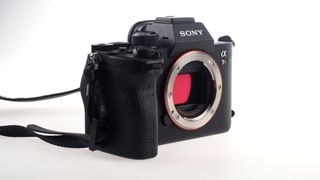
Specifications
Sony model number: ILCE-7RM4
Sensor: 61MP full frame Exmor R CMOS sensor
Image processor: BIONZ X
AF points: Hybrid AF, 567 phase detection, 325 contrast AF points
ISO range: 100 to 32,000 (exp. 50-102,400)
Max image size: 9,504 x 6,336
Metering modes: Multi-segment, centre-weighted, spot, average, highlight
Video: 4K UHD at 30p, 24p
Viewfinder: EVF, 5.76m dots
Memory card: 2x SD/SDHC/SDXC (UHS II)
LCD: 3-inch tilting touchscreen, 1.44m dots
Max burst: 10fps
Connectivity: Wi-Fi, Bluetooth, NFC
Size: 128.9 x 96.4 x 77.5mm
Weight: 655g (body only, with battery and SD card)
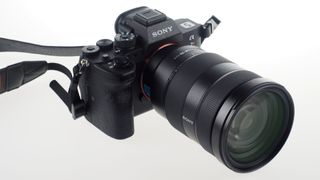
Key features
61 millions pixels is a ground-breaking resolution for full frame cameras, but it’s worth pointing out that this increase is spread across both the image width and height, so the Sony’s images are not THAT much larger than those of the Nikon Z 7, say, measuring 9,504 x 6,336 pixels (Sony) versus 8,256 x 5,504 pixels (Nikon). That’s an increase in image width and height of 15%.
What’s truly impressive is how Sony has managed to maintain a 10fps continuous shooting speed despite the massive increase in the data that’s being captured and processed. True, the buffer capacity is restricted to 68 raw files/JPEGS, but it’s also possible to shoot in an APS-C mode that captures 26 megapixel images and with 3x the buffer capacity (claimed).
Sony’s latest AF system brings 567 phase detection AF points covering 74% of the image area (or the entire area in APS-C mode) and both human and animal eye tracking.
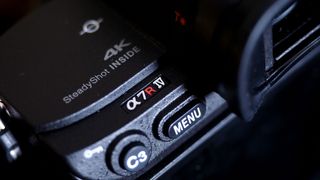
Video performance gets a boost with the addition of Real-Time AF, but otherwise it does feel as if Sony is resting on its laurels somewhat. There’s still no 50/60p 4K video capability, nor 10-bit capture, and if you want the best ‘oversampled’ quality you need to use the cropped Super 35 mode. You can capture full HD at up to 120fps and, arguably, the A7R IV is hardly a video specialist. Nevertheless, it does feel as if the video capabilities have not really advanced significantly.
Sony says its 5-axis in-body stabilisation system has been tuned for this new camera to offer up to 5.5EV compensation, and A7R IV’s Pixel Shift Multi Shooting mode can merge 16-shots made with tiny pixel-shifts between each to produce 240MP images – if you have static subjects, sufficient storage capacity and the required Sony Imaging Edge 2.0 software.
The A7R Mark IV does bring wireless tethered shooting capability, though the large files and limited wireless data bandwidth means you’re still likely to be better off with an old-fashioned cable connection.
Build and handling
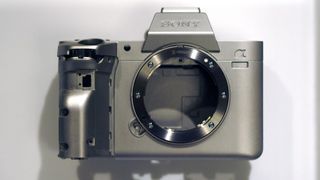
Sony’s A7 series was the first full-frame mirrorless camera design, and it’s still the smallest. That’s great in principle, but when you match up these bodies with Sony’s bigger, high-performance lenses (especially the premium G Masters like the 24-70mm f/2.8 used for most of our testing), the combination quickly starts to feel front-heavy.
This has been addressed in the A7R IV with a larger grip. It doesn’t sound much of a change but it makes a considerable difference. It’s immediately obvious when you pick up and handle these cameras side by side.
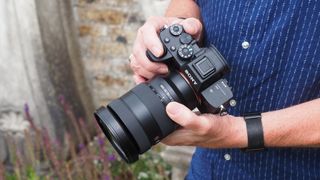
There’s a bigger AF-ON button too, and the EV compensation dial now has a lock to prevent accidental adjustments (easily done when your thumb is reaching for the rear control dial).
The EVF now has 5.76 million dots, which ought to make is super-clear, though it does have a ‘digital’ look – you can’t see the dots, of course, but object edges have a distinctly oversharpened look. It’s a reminder that EVFs are simply tiny digital screens that offer no more guarantee of accuracy than a computer monitor.
The 3-inch rear screen is starting to feel a little small on a camera of this class too, especially when shooting video, where you lose the top and bottom edges to the narrower 16:9 ratio.
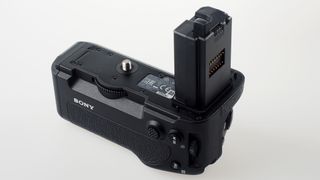
What shows up the ageing A7 design more than anything else, though, is what rival camera makers have done. The Nikon Z 6/Z 7 is a slightly larger camera that handles rather better – and has lenses that feel as if they are designed to balance properly with the body. It also has top-mounted status panel, as does the Panasonic Lumix S1R, and even larger and heavier camera, but one that has the ‘heft’ you need when you’re shooting with big and heavy professional lenses.
The A7R also relies heavily on its customisable function buttons instead of buttons specifically for functions like white balance, AF mode/area, image size/quality and so on. It also has a tiresome menu system made up of 6 tabs and no fewer than 40 individual screens.
The A7R IV isn’t a camera you can just pick up and use. You have to learn how it’s set up, where to find the functions you need and how to ‘program’ it to work the way you like. If you like tinkering and personalising, you’ll probably love it. If you like your cameras to be logical and obvious, it’s a different story.
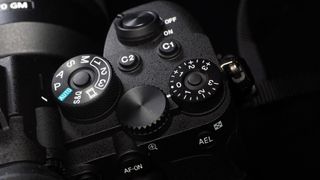
Lab tests
We tested the Sony A7R Mark IV against three key rivals, the Nikon Z 7, Panasonic Lumix S1R and Fujifilm GFX 50R. The Nikon and the Panasonic have fewer megapixels than the Sony but are still high-resolution cameras, while the GFX 50R is an interesting medium format camera designed for quality rather than speed, but a very similar price to the Sony A7R Mark IV.
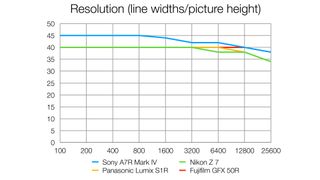
Resolution
We show this comparison chart for information purposes, but please note that only the Sony A7R Mark IV has been tested using our revised resolution test for high-resolution cameras. The other models top out at 4,000 line widths/picture height, the previous limits of our chart’s resolution.
This comparison does not show us what the Lumix S1R, Nikon Z 7 and GFX 50R might have achieved in excess of the previous 4,000 lw/ph figure, but it does show that the Sony is only a little way ahead of hat figure anyway. All of these cameras produce high levels of resolution, and it’s by no means proven that the Sony’s 61 million pixels give it a definite advantage.
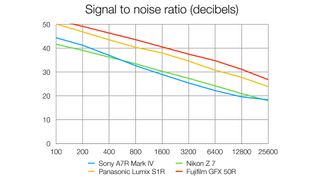
Signal to noise ratio
The Fujifilm GFX 50R wins in this test by virtue of its larger sensor and hence larger photosites, and the Lumix S1R is close behind – Panasonic cameras do tend to be very good at noise control in our lab tests. The Sony A7R Mark IV and Nikon Z 7 are a little way behind.
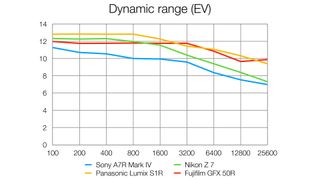
Dynamic range
Sony claims 15 stops of dynamic range for this camera, but in our lab tests the A7R IV was slightly disappointing compared to its rivals. It’s possible that real world use, careful raw processing and a different raw converter to Sony’s own will yield different results, but the lab results were nevertheless lacklustre.
Performance
On paper, the Sony A7R Mark IV looks spectacular; in practice, the advantage of its 61MP resolution over 40-50 megapixel rivals is subtler than the numbers suggest.
You do have to be particularly careful with the shutter speeds and focusing to get the full benefit of the 61MP sensor, and although Sony claims a 5.5-stop shutter speed advantage from the 5-axis in-body stabilization, you’d be unwise to rely on it completely. We tried some handheld shots with the new Sony 35mm lens at slow shutter speeds between 1/8 and 1/2sec, which should be in its safety zone, and got a pretty poor success rate.





Despite disappointing lab results, the real world dynamic range is very good. Our outdoor shots under a tricky overcast sky came out really well, with subtle sky detail and no ‘blow-out’ or colour shifts. Sony says it’s tweaked the processing to produce subtler highlight gradations, so perhaps that’s the explanation.
The color rendition is especially good, and the A7R IV produces very natural-looking JPEGs. Most of our sample shots were taken using auto white balance, and none looked as if they needed any kind of color correction.


The Eye AF works almost uncannily well as long as your subject is not moving about too quickly. It did start to lose contact with very rapid subject movements in continuous shooting/continuous AF mode, but only under pretty extreme provocation.
The A7R IV’s 10fps continuous shooting mode is amazing in a camera with this kind of resolution, but the size of its buffer shows it’s not really a sports specialist. It can capture a very creditable 68 compressed raw files in a burst, but only the same number of JPEGs, so this limits you to bursts of just under 7 seconds – and once the buffer is full, it takes some time to clear as the data is written to the memory card.

Verdict
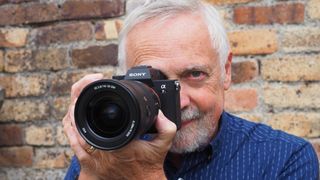
The A7R IV’s subtle design tweaks make it handle better than the A7R III before it, and with 61 million pixels it’s well ahead of all its full frame mirrorless rivals on paper. The real world definition advantage over rivals like the Nikon Z 7 and Panasonic Lumix S1R is pretty modest, though. And while Sony’s hybrid AF system just keeps on getting better and better, the 4K video stays capped at 30fps, which is a little disappointing and its design and handling have hardly moved on since the early days.
Sony's A7 series cameras have always scored highly and this one is indeed better than its predecessor in almost every way – so why doesn't it score higher? It's because the world has moved on and Sony's full frame mirrorless cameras no longer have this market to themselves. Nikon, Panasonic and Canon have shown there are different ways to design full frame cameras, certainly as far as handling and controls are concerned.
On paper, the A7R Mark IV is spectacular. In use, its shortcomings are becoming more obvious now that it has some serious competition, so it's not a straightforward win for Sony any more.
Read more:
• Which is the best Sony camera right now?
• The best Sony lenses
• These are the best mirrorless cameras today
• We list the best cameras for professionals
